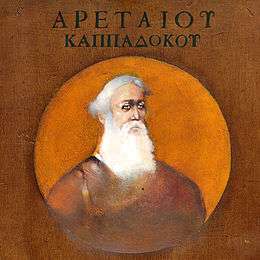Aretaeus of Cappadocia
| Aretaeus of Cappadocia | |
|---|---|
| Born | Ἀρεταῖος |
| Nationality | Greek |
| Occupation | Physician |
| Years active | 1st century CE |
| Known for | General treatise on diseases |

Aretaeus (Greek: Ἀρεταῖος) is one of the most celebrated of the ancient Greek physicians, of whose life, however, few particulars are known. He presumably was a native or at least a citizen of Cappadocia, a Roman province in Asia Minor (Turkey), and most likely lived around first century CE. He is generally styled "the Cappadocian" (Καππάδοξ).
Diagnostic method
Aretaeus wrote in Ionic Greek a general treatise on diseases, which is still extant. The valuable book displays great accuracy in the detail of symptoms, and in seizing the diagnostic character of diseases. In his practice he followed for the most part the method of Hippocrates, but he paid less attention to what have been styled "the natural actions" of the system; and, contrary to the practice of the Father of Medicine, he did not hesitate to attempt to counteract them, when they appeared to him to be injurious.
Aretaeus offered clinical descriptions of a number of diseases among which he gave classic accounts of asthma, epilepsy, pneumonia, tetanus, uterus cancer and different kinds of insanity. He differentiated nervous diseases and mental disorders and described hysteria, headaches, mania and melancholia.
The account which he gives of his treatment of various diseases indicates a simple and sagacious system, and one of more energy than that of the professed Methodici. Thus he freely administered active purgatives; he did not object to narcotics; he was much less averse to bleeding; and upon the whole his Materia Medica was both ample and efficient.
It may be asserted generally that there are few of the ancient physicians, since the time of Hippocrates, who appear to have been less biased by attachment to any peculiar set of opinions, and whose account of the phenomena and treatment of disease has better stood the test of subsequent experience. Aretaeus is placed by some writers among the Pneumatici because he maintained the doctrines which are peculiar to this sect; other systematic writers, however, think that he is better entitled to be placed with the Eclectics.
Works
Aretaeus' work consists of eight books, two De causis et signis acutorum morborum, two De causis et signis diuturnorum morborum, two De curatione acutorum morborum, and two De curatione diuturnorum morborum. They are in a tolerably complete state of preservation, though a few chapters are lost.
The work was first published in a Latin translation by Junius Paulus Crassus (Giunio Paolo Grassi), Venice 1552, together with Rufus Ephesius. The first Greek edition is that by Jacobus Goupylus, Paris, 1554, which is more complete than the Latin version of Crassus. In 1723 a major edition in folio was published at the Clarendon press at Oxford, edited by John Wigan, containing an improved text, a new Latin version, learned dissertations and notes, and a copious index by Michel Maittaire. In 1731, Boerhaave brought out a new edition, of which the text and Latin version had been printed before the appearance of Wigan's; this edition contains annotations by Pierre Petit and Daniel Wilhelm Triller. The edition by C. G. Kühn, Leipzig 1828, included Wigan's text, Latin version, dissertations, etc., together with Petit's commentary, Triller's emendations, and Maittaire's index. An edition by F. Z. Ermerins was published in Utrecht in 1847.
A more recent standard edition is by Karl Hude (1860–1936) in the Corpus medicorum graecorum (2nd ed., Berlin, Akademie-Verlag, 1958, online). The four books De causis et signis have now been issued in an annotated bilingual edition in Greek and French (Arétée de Cappadoce, Des causes et des signes des maladies aiguës et chroniques, trans. R.T.H. Laennec, ed. and comm. Mirko D. Grmek, pref. by Danielle Gourevitch, Geneva, 2000).
Literature
The medical opinions of Aretaeus have been discussed by such scholars as Johann Albert Fabricius, Albrecht von Haller, and Kurt Sprengel. Aretaeus has been treated more recently in a couple of short monographs:
- Karl Deichgräber, Aretaeus von Kappadozien als medizinischer Schriftsteller, Berlin, 1971.
- Fridolf Kudlien, Untersuchungen zu Aretaios von Kappadokien, Mainz, 1964.
For Aretaeus' influence on Giambattista Morgagni, the father of anatomical pathology, see:
- Giorgio Weber, Areteo di Cappadocia: interpretazioni e aspetti della formazione anatomo-patologica del Morgagni, Florence, 1996
References
Sources
 This article incorporates text from a publication now in the public domain: Smith, William, ed. (1870). "article name needed". Dictionary of Greek and Roman Biography and Mythology.
This article incorporates text from a publication now in the public domain: Smith, William, ed. (1870). "article name needed". Dictionary of Greek and Roman Biography and Mythology.
Further reading
- Allbutt, Sir Thomas (1970). Greek Medicine in Rome. New York: Blom. New York: Blom, 1970.
- Cordell, E. F. (1909). "Aretaeus of Cappadocia". Bulletin of the Johns Hopkins Hospital. 20: 371–377.
- Kudlien, Fridolf (1970). "Aretaeus of Cappadocia". Dictionary of Scientific Biography. 1. New York: Charles Scribner's Sons. pp. 234–235. ISBN 0-684-10114-9.
- Leopold, Eugene (1930). "Aretaeus the Cappadocian: His Contribution to Diabetes Mellitus". Annals of Medical History. 2: 424–435.
- Mettler, Cecilia (1947). History of Medicine. Philadelphia: Blakiston.
- Neuburger, Max (1910). Playtair, Ernest, ed. History of Medicine. London: Frowde.
- Robinson, Victor (1929). Pathfinders in Medicine. New York: Medical Life Press.
- Stannard, J. (March 1964). "Materia Medica and Philosophic Theory in Aretaeus". Sudhoffs Archiv für Geschichte der Medizin und der Naturwissenschaften. 48: 27–53.
- Magill, Frank Northen; Aves, Alison (1998). Dictionary of World Biography. Taylor & Francis. ISBN 9781579580407. Retrieved 22 November 2013.
External links
- Aretaeus' complete works in Greek and English (edition of Francis Adams, 1856) at the Digital Hippocrates project
- The extant works of Aretaeus, the Cappadocian, edited and translated by Francis Adams, London, printed for the Sydenham Society, 1856